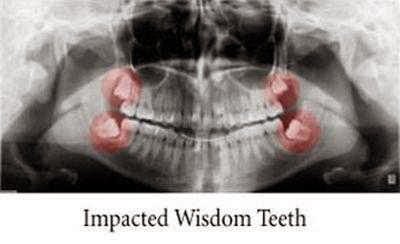
An IMPACTED TOOTH is one that fails to erupt into the dental arch within the specific time. Because impacted teeth do not erupt, they are retained throughout the individual's lifetime unless extracted or exposed surgically. Teeth may become impacted because of adjacent teeth, dense overlying bone, excessive soft tissue or a genetic abnormality. Most often, the cause of impaction is inadequate arch length and space in which to erupt. That is the total length of the alveolar arch is smaller than the tooth arch (the combined mesiodistal width of each tooth). The third molars are frequently impacted because they are the last teeth to erupt in the oral cavity. Mandibular third molars are more commonly impacted than their maxillary counterparts. As a general rule, all impacted teeth must be removed unless otherwise contraindicated.
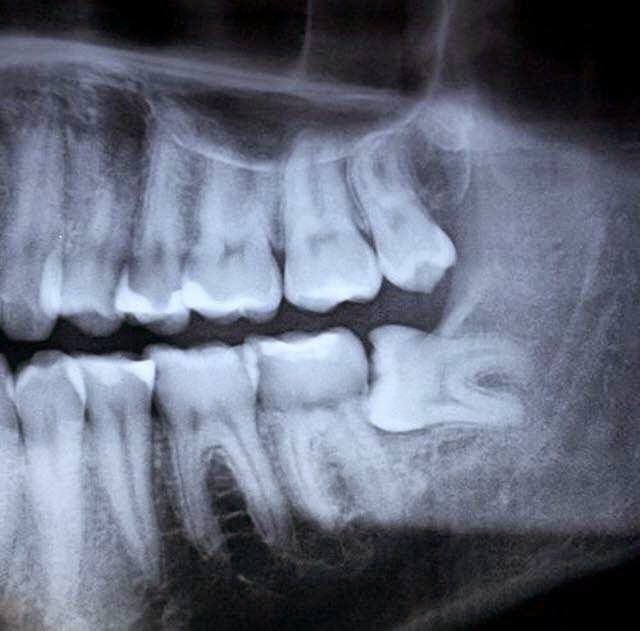
Horizontal Impaction of 3rd Molar.
CLASSIFICATION
Classifications enable the oral surgeon to determine the difficulty in removal of the impacted tooth. The primary factor determining the difficulty is accessibility, which is determined by adjacent teeth or other structures that impair access or delivery pathway. The majority of classification schemes are based on analysis on a radiograph. The most frequently considered factors are discussed below.
Angulation of teeth
Most commonly used classification system with respect to treatment planning. Depending on the angulation the tooth might be classified as:
1. Mesioangular
2. Horizontal
3. Vertical
4. Distoangular
5. Palatal
6. Buccal
7. Lingual
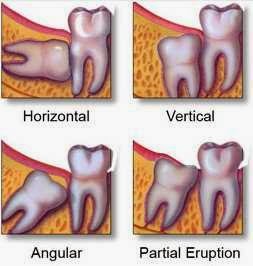
Teeth start to pass through the gums (emerge) during infancy, and again when the primary (baby) teeth are replaced by the permanent teeth.
If a tooth fails to emerge, or emerges only partially, it is considered to be impacted. The most common teeth to become impacted are the wisdom teeth (the third set of molars). They are the last teeth to emerge, usually between the ages of 17 and 21.
An impacted tooth remains stuck in gum tissue or bone for various reasons. It may be that the area is just overcrowded and there's no room for the teeth to emerge. For example, the jaw may be too small to fit the wisdom teeth. Teeth may also become twisted, tilted, or displaced as they try to emerge, resulting in impacted teeth.
Impacted wisdom teeth are very common. They are often painless and cause no apparent trouble. However, some professionals believe an impacted tooth pushes on the next tooth, which pushes the next tooth, eventually causing a misalignment of the bite. A partially emerged tooth can trap food, plaque, and other debris in the soft tissue around it, leading to inflammation and tenderness of the gums and unpleasant mouth odor. This is called pericoronitis.
Symptoms
Bad breath
Difficulty opening the mouth (occasionally)
Pain or tenderness of the gums (gingiva) or jaw bone
Prolonged headache or jaw ache
Redness and swelling of the gums around the impacted tooth
Swollen lymph nodes of the neck (occasionally)
Unpleasant taste when biting down on or near the area
Visible gap where a tooth did not emerge.

Tests and Examination
Your dentist will look for swollen tissue over the area where a tooth has not emerged, or has only partially emerged. The impacted tooth may be pressing on nearby teeth. The gums around the area may show signs of infection such as redness, drainage, and tenderness. As gums swell over impacted wisdom teeth and then drain and tighten, it may feel like the tooth came in and then went back down again.
Dental x-rays confirm the presence of one or more teeth that have not emerged.
Treatment
No treatment may be needed if the impacted tooth is not causing any problems.
Over-the-counter pain relievers may help if the impacted tooth causes discomfort. Warm salt water (one-half teaspoon of salt in one cup of water) or over-the-counter mouthwashes may be soothing to the gums.
Removal of the tooth (extraction) is the usual treatment for an impacted tooth. This is usually done in the dentist's office, but difficult cases may require an oral surgeon. Antibiotics may be prescribed before the extraction if the tooth is infected.

Prognosis
Impacted teeth may cause no problems for some people and may never require treatment. Treatment is usually successful when it does cause symptoms.
It is often preferable to have wisdom teeth removed before age 30 due to the flexibility of bone, which will allow an easier removal and better healing. As a person ages, the bone becomes more rigid and complications can develop.
Complications
Complications of an impacted tooth include:
- Abscess of the tooth or gums
- Chronic discomfort in the mouth
- Infection
- Malocclusion of the teeth
- Plaque trapped between teeth and gums
WISDOM TEETH
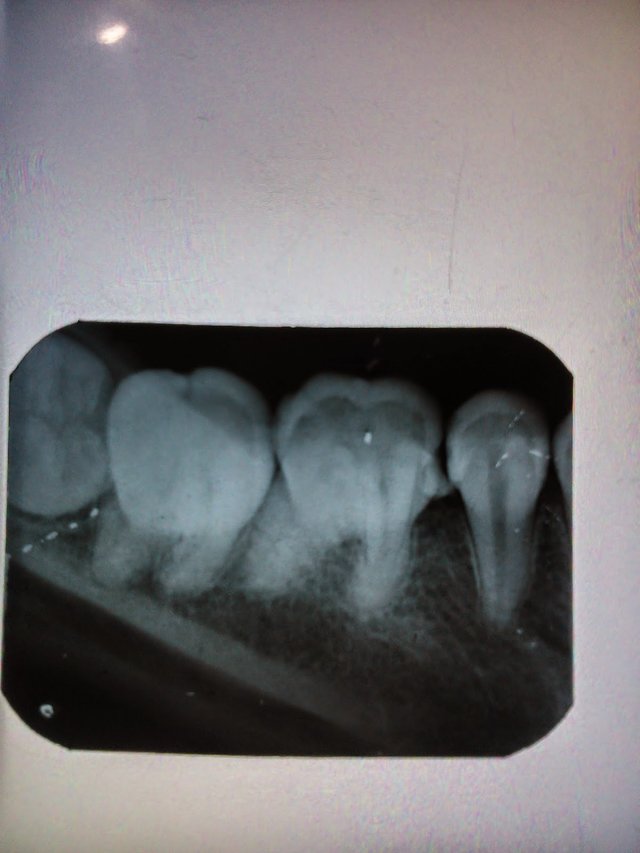
Horizontal Impaction Of Mandibular Left 3rd Molar
Wisdom teeth are the third and final set of molars that most people get in their late teens or early twenties. Sometimes these teeth can be a valuable asset to the mouth when healthy and properly aligned, but more often, they are misaligned and require removal.
When wisdom teeth are misaligned, they may position themselves horizontally, be angled toward or away from the second molars, or be angled inward or outward. Poor alignment of wisdom teeth can crowd or damage adjacent teeth, the jawbone, or nerves.
Wisdom teeth may not need to be removed if they are:
— Healthy
— Grown in completely (fully erupted)
— Positioned correctly and biting properly with their opposite teeth
— Able to be cleaned as part of daily hygiene practices.
Many times, however, wisdom teeth — the third molars in the very back of your mouth — don't have room to grow properly and can cause problems. Erupting wisdom teeth can grow at
various angles in the jaw, sometimes even horizontally.
Sometimes wisdom teeth only partially emerge through the gums. Other times, they remain completely hidden. Wisdom teeth that aren't able to emerge normally become impacted, or trapped,
within your jaw.
If the wisdom teeth emerge partially through the gums, a passage way is created, which can cause problems. And because this area is hard to see
and clean, it can become a magnet for bacteria that cause gum disease and oral infection.
Some dentists recommend removing wisdom teeth if they don't fully emerge or if they grow near the nerve of the lower jaw. Many dentists believe it's
better to remove wisdom teeth before the roots are fully formed, when someone is younger and more likely to recover faster from surgery. This is why some young adults have their wisdom teeth pulled
before the teeth cause problems and become more firmly rooted in the jaw.
According to the American Dental Association, wisdom teeth removal may be necessary if you experience changes in the area of those teeth, such as:
— Pain
— Repeated infection of soft tissue behind the lower last tooth
— Cysts (fluid-filled sacs)
— Tumors
— Damage to nearby teeth
— Gum disease
— Extensive tooth decay.
The decision to remove wisdom teeth isn't always clear. Talk to your dentist or an oral surgeon about the position and health of your wisdom teeth and what is best for the situation.
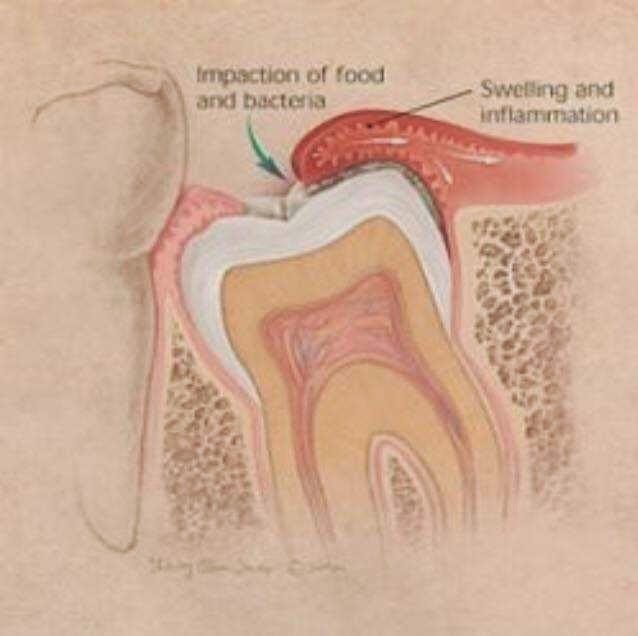
Treatment
The relative ease at which your dentist or oral surgeon can extract your wisdom teeth depends on their position and stage of development. Your oral health care provider will be able to give you an idea of what to expect during your pre-extraction exam. A wisdom tooth that is fully erupted through the gum can be extracted as easily as any other tooth. However, a wisdom tooth that is underneath the gums and embedded in the jawbone will require an incision into the gums and then removal of the portion of bone that lies over the tooth. Often, for a tooth in this situation, the tooth will be extracted in small sections rather than removed in one piece to minimize the amount of bone that needs to be removed to get the tooth out.

Surgical Removal of Impacted tooth